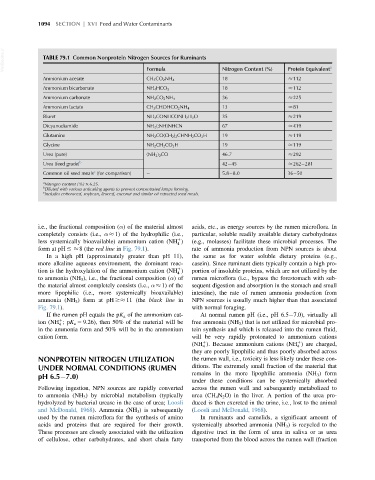Page 1162 - Veterinary Toxicology, Basic and Clinical Principles, 3rd Edition
P. 1162
1094 SECTION | XVI Feed and Water Contaminants
VetBooks.ir TABLE 79.1 Common Nonprotein Nitrogen Sources for Ruminants Nitrogen Content (%) Protein Equivalent a
Formula
Ammonium acetate CH 3 CO 2 NH 4 18 112
Ammonium bicarbonate NH 4 HCO 3 18 112
Ammonium carbonate NH 2 CO 2 NH 4 36 225
Ammonium lactate CH 3 CHOHCO 2 NH 4 13 81
Biuret NH 2 CONHCONH 2 H 2 O 35 219
Dicyanodiamide NH 2 (:NH)NHCN 67 419
Glutamine NH 2 CO(CH 2 ) 2 CHNH 2 CO 2 H 19 119
Glycine NH 2 CH 2 CO 2 H 19 119
Urea (pure) (NH 2 ) 2 CO 46.7 292
Urea (feed grade) b 42 45 262 281
c
Common oil seed meals (for comparison) 5.8 8.0 36 50
a Nitrogen content (%) 3 6.25.
b Diluted with various anticaking agents to prevent concentrated lumps forming.
c
Includes cottonseed, soybean, linseed, coconut and similar oil extracted seed meals.
i.e., the fractional composition (α) of the material almost acids, etc., as energy sources by the rumen microflora. In
completely consists (i.e., α 1) of the hydrophilic (i.e., particular, soluble readily available dietary carbohydrates
1
less systemically bioavailable) ammonium cation (NH ) (e.g., molasses) facilitate these microbial processes. The
4
form at pH # 8 (the red line in Fig. 79.1). rate of ammonia production from NPN sources is about
In a high pH (approximately greater than pH 11), the same as for water soluble dietary proteins (e.g.,
more alkaline aqueous environment, the dominant reac- casein). Since ruminant diets typically contain a high pro-
1
tion is the hydroxylation of the ammonium cation (NH ) portion of insoluble proteins, which are not utilized by the
4
to ammonia (NH 3 ), i.e., the fractional composition (α)of rumen microflora (i.e., bypass the forestomach with sub-
the material almost completely consists (i.e., α 1) of the sequent digestion and absorption in the stomach and small
more lipophilic (i.e., more systemically bioavailable) intestine), the rate of rumen ammonia production from
ammonia (NH 3 ) form at pH $ 11 (the black line in NPN sources is usually much higher than that associated
Fig. 79.1). with normal foraging.
If the rumen pH equals the pK a of the ammonium cat- At normal rumen pH (i.e., pH 6.5 7.0), virtually all
1
ion (NH ;pK a 5 9.26), then 50% of the material will be free ammonia (NH 3 ) that is not utilized for microbial pro-
4
in the ammonia form and 50% will be in the ammonium tein synthesis and which is released into the rumen fluid,
cation form. will be very rapidly protonated to ammonium cations
1
1
(NH ). Because ammonium cations (NH ) are charged,
4 4
they are poorly lipophilic and thus poorly absorbed across
NONPROTEIN NITROGEN UTILIZATION the rumen wall, i.e., toxicity is less likely under these con-
UNDER NORMAL CONDITIONS (RUMEN ditions. The extremely small fraction of the material that
remains in the more lipophilic ammonia (NH 3 ) form
pH 6.5 7.0)
under these conditions can be systemically absorbed
Following ingestion, NPN sources are rapidly converted across the rumen wall and subsequently metabolized to
to ammonia (NH 3 ) by microbial metabolism (typically urea (CH 4 N 2 O) in the liver. A portion of the urea pro-
hydrolyzed by bacterial urease in the case of urea; Loosli duced is then excreted in the urine, i.e., lost to the animal
and McDonald, 1968). Ammonia (NH 3 ) is subsequently (Loosli and McDonald, 1968).
used by the rumen microflora for the synthesis of amino In ruminants and camelids, a significant amount of
acids and proteins that are required for their growth. systemically absorbed ammonia (NH 3 ) is recycled to the
These processes are closely associated with the utilization digestive tract in the form of urea in saliva or as urea
of cellulose, other carbohydrates, and short chain fatty transported from the blood across the rumen wall (fraction

